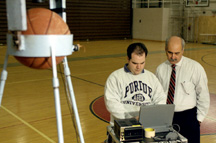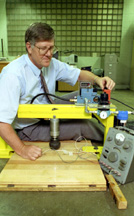 Purdue News
Purdue News
 Purdue News
Purdue News
It's the floor.
 Unfortunately, little information exists about what makes for a floor that provides
a good landing -- or even what makes for a dangerously dead floor that puts the athletes
at risk for injury.
Unfortunately, little information exists about what makes for a floor that provides
a good landing -- or even what makes for a dangerously dead floor that puts the athletes
at risk for injury.
Although it's a concern to athletic teams who invest mega-millions in their athletes, the issue of floor safety is perhaps even more important to recreational athletes who hope to continue exercising throughout their lives and avoid chronic injuries.
Now, scientists at Purdue University are establishing the first standards for wood floors for participants in basketball, dance and aerobics. Currently, no standards or specifications exist in the United States, and some arenas in Europe rely on specifications created in Germany in the mid-1950s.
"We're quantifying energy absorption and trying to relate that to comfort, safety and performance values of various floors so that we can better redirect the force of the landing," says Gary Krutz, professor of agricultural and biological engineering. "We're trying to separate intuition from what is actually happening. Right now athletic floor design is done by trial and error, and people argue about what is really going on."
The research at Purdue is being funded by Robbins Inc. (https://www.robbinsfloor.com) of Cincinnati, which supplies flooring for 20 of the 29 NBA teams and is supplying flooring for nine venues at the 1996 Summer Olympic Games in Atlanta.
Most basketball floors are made of northern hard maple. Wood floors are known for their beauty, but wood is more difficult for engineers to work with than concrete or steel.
"Wood floors are very challenging from an engineering standpoint because they are biological material and by their nature more complex, even though they are in a dead state," says Kamyar Haghighi, professor of agricultural and biological engineering. "They are still quite dynamic, which means that time, temperature or moisture can change their properties. What's more, these changes occur differently in different directions depending on the grain, and it's not a linear change, so it is very complex."
 Using the testing now going on, the Purdue researchers have developed computer models
that allow them to predict how a floor will react to various forces and environment
changes. "We are using a computer-modeling technique called finite element analysis,
where we look at very small portions of a large area of the floor, predict how these
small portions of the floor will react, and assemble these to get an idea of how
an individual board or section of the floor will react," Haghighi says.
Using the testing now going on, the Purdue researchers have developed computer models
that allow them to predict how a floor will react to various forces and environment
changes. "We are using a computer-modeling technique called finite element analysis,
where we look at very small portions of a large area of the floor, predict how these
small portions of the floor will react, and assemble these to get an idea of how
an individual board or section of the floor will react," Haghighi says.
Using a 40-pound weight dropped onto the floor with a customized piece of equipment, the testing attempts to replicate the impact of an athlete. Sensors placed around the floor measure both the amount of force returned to the athlete and how easily the floor dissipates the energy of the impact. Floors made of concrete are considered baseline, because they are the hardest surface used in sports.
In a well-designed floor, a board can deflect 3 millimeters at the site of the impact, and as much as 0.6 mm 20 inches away.
The initial findings of the tests at Purdue show that the uniformity of the floor can be as important as the overall ability of the floor to disperse the force of the athlete landing.
"We've discovered that floors that are inconsistent are actually more of a concern than floors that don't absorb impact adequately," Haghighi says.
Also in the near future, the researchers hope to apply the knowledge gleaned from the computer models to what already is known in the biomedical community about chronic athletic injuries. The researchers hope to look at injuries in athletes of all abilities and ages, especially school children.
As the specifications for adequate flooring are established, regular testing of floors may become commonplace so that sections of the floor that aren't performing adequately can be replaced.
"Right now it looks as though floors might be tested when they are new, with follow-up tests later. An NBA team or a major college team, for example, may want to test their floor each year. A smaller college or high school might want to test their floors every few years," Haghighi says.
swt/haghighi/9604f5
NOTE TO JOURNALISTS: Broadcast quality b-roll and interviews are available. Two color photos of the researchers conducting different tests on a basketball floor also are available. Contact Purdue News Service, (765) 494-2096. Ask for the photos called "Floors/Haghighi1" and "Floors/Haghighi2." or download Haghighi1 or Highighi2 here
Sources: Kamyar Haghighi, (765) 494-1182; home, (765) 497-7014; haghighi@ecn.purdue.edu
Gary Krutz, (765) 494-1179; home, (765) 463-5704; krutz@ecn.purdue.edu
Mike Niese, research director, Robbins Inc. 1-800-543-1913; mniese@robbins.ccmail.compuserve.com
Jay Cooper, marketing manager, Robbins Inc., (513) 871-8988; jcooper@robbinsfloor.com
Writer: Steve Tally, (765) 494-9809; home, (765) 463-4355; tally@aes.purdue.edu